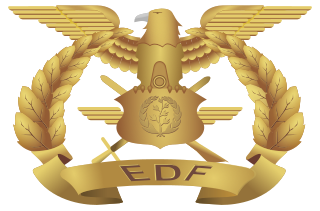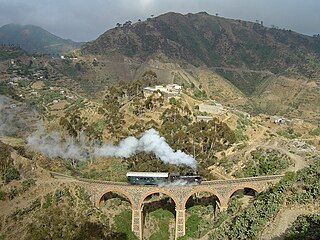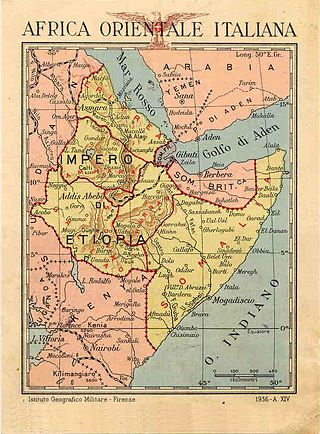
"Eritrea" is an ancient name, associated in the past with its Greek form Erythraia, Ἐρυθραία, and its derived Latin form Erythræa. This name relates to that of the Red Sea, then called the Erythræan Sea, from the Greek for "red", ἐρυθρός, erythros. The Italians created the colony of Eritrea in the 19th century around Asmara, and named it with its current name. After World War II, Eritrea was annexed to Ethiopia. In 1991, the communist Ethiopian government was toppled by Eritrean people liberation front (EPLF) which earned their independence. Eritrea officially celebrated its 1st anniversary of independence on May 24, 1991

The Eritrean Defence Forces (EDF) are the combined military forces of Eritrea composed of three branches: Eritrean Army, Eritrean Air Force and Eritrean Navy. The Army is by far the largest, followed by the Air Force and Navy. The Commander-in-Chief of the EDF is the President of Eritrea. Their military role stems from Eritrea's strategic geographical location, located on the Red Sea with a foothold on the Bab-el-Mandeb strait.

The Eritrean Railway is the only railway system in Eritrea. It was constructed between 1887 and 1932 during the Italian Eritrea colony and connects the port of Massawa with Asmara. Originally it also connected to Bishia. The line was partly damaged by warfare in subsequent decades, but was rebuilt in the 1990s. Vintage equipment is still used on the line.

Isaias Afwerki is an Eritrean politician and partisan who has been the president of Eritrea since shortly after he led the Eritrean People's Liberation Front (EPLF) to victory in May 1991, ending the 30-year-old war for independence from Ethiopia.

Massawa is a port city in the Northern Red Sea region of Eritrea, located on the Red Sea at the northern end of the Gulf of Zula beside the Dahlak Archipelago. It has been a historically important port for many centuries.

The Eritrean People's Liberation Front (EPLF), colloquially known as Shabia, was an armed Marxist–Leninist organization that fought for the independence of Eritrea from Ethiopia. It emerged in 1970 as a far-left to left-wing nationalist group that split from the Eritrean Liberation Front (ELF). After achieving Eritrean independence in 1991, it transformed into the People's Front for Democracy and Justice (PFDJ), which serves as Eritrea's sole legal political party.

The Eritrean War of Independence was a war for independence which Eritrean independence fighters waged against successive Ethiopian governments from 1 September 1961 to 24 May 1991.
Articles related to Eritrea include:
The Battle of Afabet was fought from 17 March through 20 March 1988 in and around the town of Afabet, as part of the Eritrean War of Independence.
The Battle of Massawa took place from 1977 to 1978 in and around the coastal city of Massawa in Eritrea. The port was besieged by the Eritrean People's Liberation Front (EPLF) against the forces of Ethiopia, and was one of two battles in and around the city.
The Second Battle of Massawa took place in 1990 in and around the coastal city of Massawa in Eritrea. The offensive was conducted by both land and sea units of the Eritrean People's Liberation Front (EPLF) against the Ethiopian Army.

The Ethiopian Navy, known as the Imperial Ethiopian Navy until 1974, was a branch of the Ethiopian National Defense Force founded in 1955. It was disestablished in 1996 after the independence of Eritrea in 1991 left Ethiopia landlocked.

The Eritrean Civil Wars were two conflicts that were fought between competing organizations for the liberation of Eritrea.

Italian Eritrea was a colony of the Kingdom of Italy in the territory of present-day Eritrea. The first Italian establishment in the area was the purchase of Assab by the Rubattino Shipping Company in 1869, which came under government control in 1882. Occupation of Massawa in 1885 and the subsequent expansion of territory would gradually engulf the region and in 1889 borders with the Ethiopian Empire were defined in the Treaty of Wuchale. In 1890 the Colony of Eritrea was officially founded.

Eritrea Governorate was one of the six governorates of Italian East Africa. Its capital was Asmara. It was formed from the previously separate colony of Italian Eritrea, which was enlarged with parts of the conquered Ethiopian Empire following the Second Italo-Ethiopian War.

Bereket Mengisteab is a well-known Eritrean songwriter, composer and singer and is known as the "Godfather of Eritrean music".

The fall of the Derg, also known as Downfall of the Derg, was a military campaign that resulted the defeat of the ruling military junta Derg by the rebel coalition Ethiopian People's Revolutionary Democratic Front (EPRDF) on 28 May 1991 in Addis Ababa, ending the Ethiopian Civil War. The Derg took power after deposing Emperor Haile Selassie and the Solomonic dynasty, an imperial dynasty of Ethiopia that began in 1270. The Derg suffered insurgency with different factions, and separatist rebels groups since early their rule, beginning with the Ethiopian Civil War. The 1983–1985 famine, the Red Terror, and resettlement and villagization infamed the Derg with majority of Ethiopians tended to support insurgent groups like the Tigray People's Liberation Front (TPLF) and Eritrean People's Liberation Front (EPLF).















